- Home
- Umberto Eco
Six Walks in the Fictional Woods
Six Walks in the Fictional Woods Read online
THE CHARLES ELIOT NORTON LECTURES • 1993
SIX WALKS IN THE FICTIONAL WOODS
UMBERTO ECO
SIX WALKS IN THE FICTIONAL WOODS
HARVARD UNIVERSITY PRESS
Cambridge Massachusetts and London England
Copyright © 1994 by the President and Fellows of Harvard College
All rights reserved
Printed in the United States of America
Eighth printing, 2004
First Harvard University Press paperback edition, 1995
“Scenes We’d Like to See: The Musketeer Who Failed to Get the Girl,” by Phil
Interlandi, is from Mad magazine no. 27,
© 1955 by E. C. Publications, Inc., and is used with permission.
Library of Congress Cataloging-in-Publication Data
Eco, Umberto.
Six walks in the fictional woods / Umberto Eco.
p. cm.—(The Charles Eliot Norton lectures; 1993)
Includes index.
ISBN 0-674-81050-3 (cloth)
ISBN 0-674-81051-1 (pbk.)
1. Fiction—Technique. 2. Narration
(Rhetoric) 3. Nerval, Gérard de, 1808-1855.
Sylvie. I. Title. II. Series.
PN3355.E28 1994
808.3—dc20
93-33605
CIP
CONTENTS
1 ENTERING THE WOODS
2 THE WOODS OF LOISY
3 LINGERING IN THE WOODS
4 POSSIBLE WOODS
5 THE STRANGE CASE OF THE RUE SERVANDONI
6 FICTIONAL PROTOCOLS
NOTES
INDEX
ONE
ENTERING THE WOODS
I would like to begin by evoking the memory of Italo Calvino, who eight years ago was invited to give his six Norton lectures but who had time to write only five of them before leaving us. I evoke him not merely as my friend but also as the author of If on a Winter’s Night a Traveler, because his novel is concerned with the presence of the reader in the story and my lectures will to a great extent be devoted to the same subject.
In the same year that Calvino’s book came out in Italy, one of my own books was published—namely, Lector in fabula, which corresponds only in part to the English version, The Role of the Reader. The English and Italian titles of this work are different because, if the Italian (or Latin) title were translated literally into English, it would be “The Reader in the Fairy Tale,” which means nothing. In Italy the expression “Lupus in fabula” is the equivalent of “Speak of the devil,” and is used when an individual whom people have just been talking about suddenly turns up. But whereas the Italian expression summons the wolf, which appears in all folktales, I refer instead to the reader. Indeed, the wolf may not even figure in many situations, and we shall soon see that in its place there could be an ogre. But in a story there is always a reader, and this reader is a fundamental ingredient not only of the process of storytelling but also of the tale itself.
Today, anyone who compared my Lector in fabula with If on a Winter’s Night a Traveler might think that my book was a response to Calvino’s novel. But the two works came out at about the same time and neither of us knew what the other was doing, even though for a long time we had both been deeply preoccupied with the same problems. When Calvino sent me his book, he had certainly already received mine, since his dedication reads, “A Umberto: superior stabat lector, longeque inferior Italo Calvino.” The quotation is obviously adapted from Phaedrus’ fable about the wolf and the lamb (“Superior stabat lupus, longeque inferior agnus,” or “The wolf was upstream and the lamb downstream”), and Calvino was alluding to my Lector in fabula. But the phrase “longeque inferior,” which means both “downstream” and “inferior” or “less important,” is still referentially ambiguous. If the word “lector” is to be taken de dicto as designating my book, Calvino was either choosing an ironically humble role or proudly taking on the positive one of the lamb, leaving the theorist with that of the Big Bad Wolf. If, on the contrary, the word “lector” is to be taken de re and meant the Reader, Calvino was making a major statement and was paying homage to the role of the reader.
To pay homage to Calvino, I shall take as my starting point the second of Calvino’s Six Memos for the Next Millennium1 (his Norton lectures), the “memo” dedicated to quickness, in which he refers to the fifty-seventh tale in his anthology Italian Folktales:
A king fell ill and was told by his doctors, “Majesty, if you want to get well, you’ll have to obtain one of the ogre’s feathers. That will not be easy, since the ogre eats every human he sees.”
The king passed the word on to everybody, but no one was willing to go to the ogre. Then he asked one of his most loyal and courageous attendants, who said, “I will go.”
The man was shown the road and told, “On a mountaintop are seven caves, in one of which lives the ogre.”2
Calvino remarks that “not a word is said about what illness the king was suffering from, or why on earth an ogre should have feathers, or what those caves were like,” and he praises the quality of swiftness in a narrative, although he asserts that “this apologia for quickness does not presume to deny the pleasures of lingering.”3 I shall devote my third lecture to lingering. For the moment, let us note that any narrative fiction is necessarily and fatally swift because, in building a world that comprises myriad events and characters, it cannot say everything about this world. It hints at it and then asks the reader to fill in a whole series of gaps. Every text, after all (as I have already written), is a lazy machine asking the reader to do some of its work. What a problem it would be if a text were to say everything the receiver is to understand—it would never end. If I were to phone you and say, “I’ll take the highway and be with you in an hour,” you would not expect me to add that I shall use my car along with the highway.
In Agosto, moglie mia non ti conosco, the great comic writer Achille Campanile wrote the following dialogue:
Gedeone gestured wildly to a carriage standing at the end of the street. The elderly coachman climbed down from the driver’s seat with difficulty and walked as quickly as he could toward our friends, saying, “How can I help you?”
“No!” cried Gedeone irritably, “I want the carriage!”
“Oh!” replied the coachman with disappointment, “I thought you wanted me.”
He returned to the carriage, climbed into the driver’s box, and asked Gedeone, who had taken his seat in the vehicle along with Andrea: “Where to?”
“I can’t tell you,” said Gedeone, who wanted to keep his expedition a secret. The coachman, who was not very inquisitive, did not persist. They all sat motionless for a few minutes, looking at the view. In the end, Gedeone, unable to control himself any longer, exclaimed, “To Fiorenzina castle!”—which made the horse start and led the coachman to protest, “At this time of day? We’ll get there after nightfall.”
“That’s true,” muttered Gedeone. “We’ll go tomorrow morning. Come and collect us at seven o’clock sharp.”
“In the carriage?” inquired the coachman. Gedeone reflected for a few minutes. Finally he said, “Yes, that would be better.”
As he was heading back to the inn he turned and shouted to the coachman, “Hey! Don’t forget the horse!”
“Are you serious?” said the other man in surprise. “Well, as you wish.”4
The passage is absurd because the protagonists at first say less than they should and in the end feel the urge to say (and hear) what it is not necessary to say.
At times, in wanting to say too much, an author may become more comic than his or her characters. A very popular writer in nineteenth-century Italy was Carolina Invernizio,
who nourished the dreams of whole generations of proletarians with stories such as A Dead Woman’s Kiss, A Madwoman’s Revenge, and The Accusing Corpse. Carolina Invernizio wrote quite badly, and my translation will be rather faithful. It has been remarked that she had the courage, or the weakness, to introduce into literature the language of the petty bureaucracy of the newly formed Italian state (a bureaucracy to which her husband, manager of a military bakery, belonged). This is how Carolina begins her novel The Murderous Inn:
It was a beautiful evening, even if it was very cold. The streets of Turin were illuminated as if by daylight by the moon high in the sky. The station clock showed seven o’clock. Under the large porch a deafening noise could be heard because two nonstop trains were meeting. One about to leave, the other about to arrive.5
We should not be too hard on Mrs. Invernizio. She somehow felt that speed is a great narrative virtue, but she could never have begun, as Kafka did (in his “Metamorphosis”), with the sentence: “As Gregor Samsa awoke one morning from uneasy dreams he found himself transformed in his bed into a gigantic insect.”6 Her readers would have immediately asked her how and why Gregor Samsa had become an insect and what he had eaten the day before. Incidentally, Alfred Kazin relates that Thomas Mann lent one of Kafka’s novels to Einstein, who gave it back to him saying: “I couldn’t read it; the human mind isn’t that complex.”7
Einstein was perhaps complaining that the story was rather slow (but I shall later praise the art of slowing down). Indeed, the reader does not always know how to collaborate with the speed of the text. In Reading and Understanding, Roger Schank tells us another story:
John loved Mary but she didn’t want to marry him. One day, a dragon stole Mary from the castle. John got on top of his horse and killed the dragon. Mary agreed to marry him. They lived happily ever after.8
In this book Schank is concerned with what children understand when they read, and he asked a three-year-old girl about the story.
P: Why did John kill the dragon?
C: ’Cause it was mean.
P: What was mean about it?
C: It was hurting him.
P: How did it hurt him?
C: It was probably throwing fire at him.
P: Why did Mary agree to marry John?
C: ’Cause she loved him very much and he wanted very much to marry her . . .
P: How come Mary decided to marry John when she wouldn’t in the beginning?
C: That’s a hard question.
P: Well, what do you think the answer is?
C: Because then she just didn’t want him and then he argued very much and talked to her a lot about marrying her and then she got interested in marrying her, I mean him.
Evidently, the girl’s knowledge of the world included the fact that dragons breathe flames from their nostrils but not that you can yield, out of gratitude or admiration, to a love you do not reciprocate. A story may be more or less quick—that is to say, more or less elliptic—but how elliptic it may be is determined by the sort of reader it is addressed to.
Since I try to justify all the titles I have been foolish enough to choose for my works, let me also justify the title of my Norton lectures. Woods are a metaphor for the narrative text, not only for the text of fairy tales but for any narrative text. There are woods like Dublin, where instead of Little Red Riding Hood one can meet Molly Bloom, and woods like Casablanca, in which one can meet Ilsa Lund or Rick Blaine.
To use a metaphor devised by Jorge Luis Borges (another spirit who is very much present in these talks and who gave his own Norton lectures twenty-five years ago), a wood is a garden of forking paths. Even when there are no well-trodden paths in a wood, everyone can trace his or her own path, deciding to go to the left or to the right of a certain tree and making a choice at every tree encountered.
In a narrative text, the reader is forced to make choices all the time. Indeed, this obligation to choose is found even at the level of the individual sentence—at least, every time a transitive verb occurs. Whenever the speaker is about to end a sentence, we as readers or listeners make a bet (albeit unconsciously): we predict his or her choice, or anxiously wonder what choice will be made (at least in the case of dramatic sentences such as “Last night in the graveyard of the vicarage I saw . . .”).
Sometimes the narrator wants to leave us free to imagine how the story will continue. Let’s look, for example, at the end of Poe’s Narrative of Arthur Gordon Pym:
And now we rushed into the embraces of the cataract, where a chasm threw itself open to receive us. But there arose in our pathway a shrouded human figure, very far larger in its proportions than any dweller among men. And the hue of the skin of the figure was of the perfect whiteness of the snow.
Here, where the voice of the narrator ceases, the author wants us to spend the rest of our lives wondering what happened; and fearing that we are not yet consumed by the desire to know what will never be revealed to us, the author, not the voice of the narrator, adds a note at the end telling us that, after the disappearance of Mr. Pym, “the few remaining chapters which were to complete his narration . . . have been irrecoverably lost.” We shall never escape from that wood—as happened, for instance, to Jules Verne, Charles Romyn Dake, and H. P. Lovecraft, who decided to stay in there by trying to continue Pym’s story.
But there are cases in which the author wants sadistically to show us that we are not Stanley but Livingstone, and that we are doomed to get lost in the woods by continuing to make the wrong choices. Take Laurence Sterne, right at the beginning of Tristram Shandy:
I wish either my father or my mother, or indeed both of them, as they were in duty both equally bound to it, had minded what they were about when they begot me; had they duly consider’d how much depended upon what they were then doing . . .
What can the Shandy couple have been doing at that delicate moment? In order to leave the reader time to think out some reasonable predictions (even the most embarrassing ones), Sterne digresses for a whole paragraph (which shows that Calvino was right not to disdain the art of lingering), after which he reveals the mistake that was made in the primal scene:
Pray, my dear, quoth my mother, have you not forgot to wind up the clock?——Good G—! cried my father, making an exclamation, but taking care to moderate his voice at the same time,——Did ever woman, since the creation of the world, interrupt a man with such a silly question?
As you can see, the father thinks of the mother exactly what the reader thinks of Sterne. Was there ever an author, however evil minded, who so frustrated his readers?
Certainly, after Sterne, avant-garde narrative has often tried not only to upset our expectations as readers but even to create readers who expect complete freedom of choice from the book they are reading. Yet this freedom can be enjoyed precisely because—on the strength of a tradition thousands of years old, comprising narratives ranging from primitive myths to the modern detective novel—readers are generally willing to make their own choices in the narrative wood on the assumption that some will be more reasonable than others.
I say “reasonable” as if these were choices based on common sense. But it would be wrong to assume that a book of fiction is read according to common sense. It is certainly not what is asked of us by Sterne or Poe or even by the author (if there originally was one) of “Little Red Riding Hood.” In fact, common sense would make us reject the idea that the wood contains a wolf that talks. So what do I mean when I say that in the narrative wood the reader must make reasonable choices?
At this point I must refer to two concepts that I have already discussed elsewhere—namely, those of the Model Reader and the Model Author.9
The model reader of a story is not the empirical reader. The empirical reader is you, me, anyone, when we read a text. Empirical readers can read in many ways, and there is no law that tells them how to read, because they often use the text as a container for their own passions, which may come from outside the text or which the text may arouse by cha
nce.
If you have ever happened to watch a comedy at a time of deep sadness, you will know that a funny movie is very difficult to enjoy at such a moment. That’s not all: if you happen to see the same film again years later, you might still not be able to laugh, because every scene will remind you of the sadness you felt on the first occasion. Evidently, as an empirical spectator you would be “reading” the film in the wrong way. But “wrong” with respect to what? With respect to the type of spectators the director had in mind—that is, spectators inclined to smile and to follow a story which does not involve them personally. This type of spectator (or reader of a book) I call the model reader—a sort of ideal type whom the text not only foresees as a collaborator but also tries to create. If a text begins with “Once upon a time,” it sends out a signal that immediately enables it to select its own model reader, who must be a child, or at least somebody willing to accept something that goes beyond the commonsensical and reasonable.
A childhood friend of mine, whom I hadn’t seen for years, wrote to me after the publication of my second novel, Foucault’s Pendulum: “Dear Umberto, I do not recall having told you the pathetic story of my uncle and aunt, but I think you were very indiscreet to use it in your novel.” Well, in my book I recount a few episodes concerning an “Uncle Charles” and an “Aunt Catherine” who are the uncle and aunt of the protagonist, Jacopo Belpo, and it is true that these characters really did exist: with a few alterations, I tell a story from my childhood concerning an uncle and aunt—who had, however, different names. I wrote back to my friend saying that Uncle Charles and Aunt Catherine were my relations, not his, and that therefore I had the copyright; I was not even aware that he had had any uncles or aunts. My friend apologized: he had been so absorbed by the story that he thought he could recognize some incidents that had happened to his uncle and aunt—which is not impossible, because in wartime (which was the period to which my memories went back) similar things happen to different uncles and aunts.

 Baudolino
Baudolino The Name of the Rose
The Name of the Rose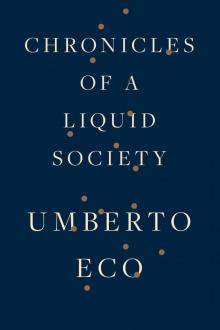 Chronicles of a Liquid Society
Chronicles of a Liquid Society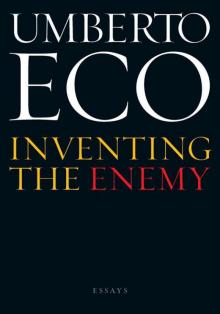 Inventing the Enemy: Essays
Inventing the Enemy: Essays Foucault's Pendulum
Foucault's Pendulum How to Travel With a Salmon & Other Essays
How to Travel With a Salmon & Other Essays Numero zero
Numero zero The Island of the Day Before
The Island of the Day Before UMBERTO ECO : THE PRAGUE CEMETERY
UMBERTO ECO : THE PRAGUE CEMETERY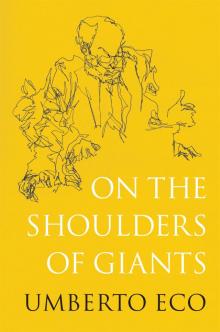 On the Shoulders of Giants
On the Shoulders of Giants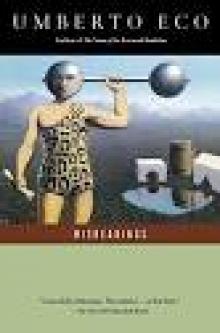 Misreadings
Misreadings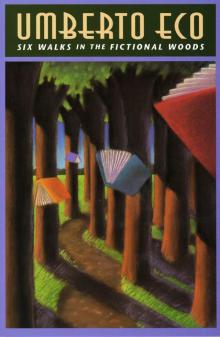 Six Walks in the Fictional Woods
Six Walks in the Fictional Woods The Mysterious Flame Of Queen Loana
The Mysterious Flame Of Queen Loana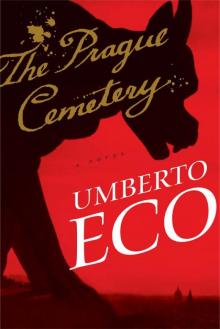 The Prague Cemetery
The Prague Cemetery On Literature
On Literature Lost structure
Lost structure